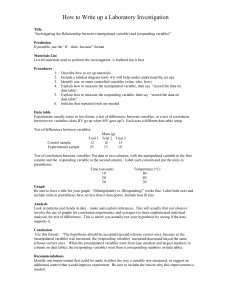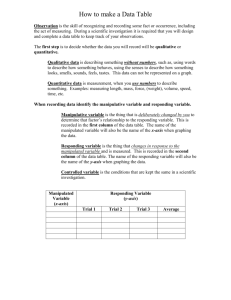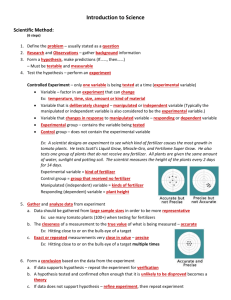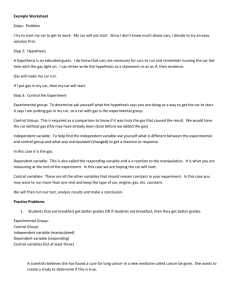Scientific Method Worksheet
advertisement
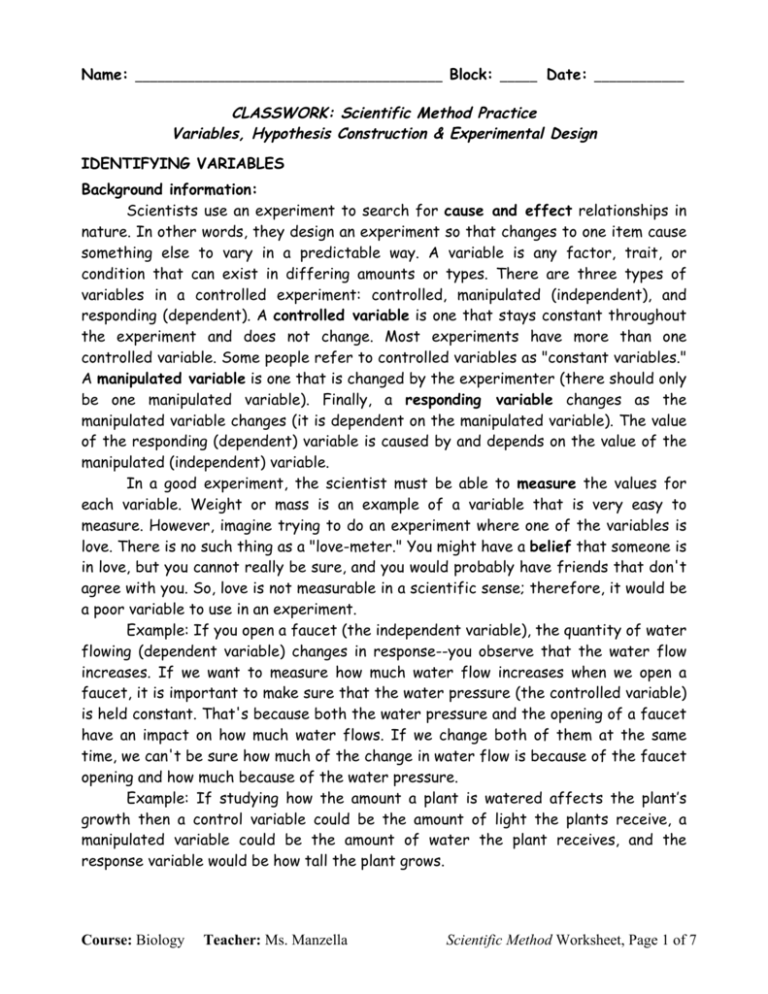
Name: _________________________________________ Block: _____ Date: ____________ CLASSWORK: Scientific Method Practice Variables, Hypothesis Construction & Experimental Design IDENTIFYING VARIABLES Background information: Scientists use an experiment to search for cause and effect relationships in nature. In other words, they design an experiment so that changes to one item cause something else to vary in a predictable way. A variable is any factor, trait, or condition that can exist in differing amounts or types. There are three types of variables in a controlled experiment: controlled, manipulated (independent), and responding (dependent). A controlled variable is one that stays constant throughout the experiment and does not change. Most experiments have more than one controlled variable. Some people refer to controlled variables as "constant variables." A manipulated variable is one that is changed by the experimenter (there should only be one manipulated variable). Finally, a responding variable changes as the manipulated variable changes (it is dependent on the manipulated variable). The value of the responding (dependent) variable is caused by and depends on the value of the manipulated (independent) variable. In a good experiment, the scientist must be able to measure the values for each variable. Weight or mass is an example of a variable that is very easy to measure. However, imagine trying to do an experiment where one of the variables is love. There is no such thing as a "love-meter." You might have a belief that someone is in love, but you cannot really be sure, and you would probably have friends that don't agree with you. So, love is not measurable in a scientific sense; therefore, it would be a poor variable to use in an experiment. Example: If you open a faucet (the independent variable), the quantity of water flowing (dependent variable) changes in response--you observe that the water flow increases. If we want to measure how much water flow increases when we open a faucet, it is important to make sure that the water pressure (the controlled variable) is held constant. That's because both the water pressure and the opening of a faucet have an impact on how much water flows. If we change both of them at the same time, we can't be sure how much of the change in water flow is because of the faucet opening and how much because of the water pressure. Example: If studying how the amount a plant is watered affects the plant’s growth then a control variable could be the amount of light the plants receive, a manipulated variable could be the amount of water the plant receives, and the response variable would be how tall the plant grows. Course: Biology Teacher: Ms. Manzella Scientific Method Worksheet, Page 1 of 7 Directions: Identify the variables in each of the following examples. A scientist was trying to see if the amount of water a plant gets affects plant growth. She collected 10 identical plants and gave them different amounts of water. She measured their growth daily. The plants received the same amount of sunlight. _____ 1. Look at the investigation above, what is the manipulated variable? A. plant growth C. amount of water B. amount of sunlight D. 10 plants _____ 2. What is the responding variable? A. amount of sunlight B. plant growth C. growth measured daily D. none of the above _____ 3. What are the controlled variable(s)? A. amount of sunlight C. amount of water B. 10 identical plants D. both A and B Identify the manipulated and responding variable(s) in each question from the information given. Then, think of at least two controlled variables that could be set for each experiment. 1. Does the shape of a container affect how fast water will evaporate from it? Manipulated variable: ____________________________________________________________ Responding variable: ____________________________________________________________ Controlled variables: ____________________________________________________________ 2. How does the distance from a flashlight to a screen effect the size of the illuminated area? Manipulated variable: ____________________________________________________________ Responding variable: ____________________________________________________________ Controlled variables: ____________________________________________________________ 3. How does the weight of a parachute effect how fast it will fall? Manipulated variable: ____________________________________________________________ Responding variable: ____________________________________________________________ Controlled variables: ____________________________________________________________ 4. Scientists were trying to determine if junk food would cause a mouse to gain weight. The diet of mice was varied. Some mice were given junk food. Others were given Mouse Chow. The mice were weighed daily. All mice were the same sex, the same age and the same type of mouse. Manipulated variable: ____________________________________________________________ Responding variable: ____________________________________________________________ Controlled variables: ____________________________________________________________ Course: Biology Teacher: Ms. Manzella Scientific Method Worksheet, Page 2 of 7 5. How does the amount of fertilizer a farmer uses effect the number of beans he harvests? Manipulated variable: ____________________________________________________________ Responding variable: ____________________________________________________________ Controlled variables: ____________________________________________________________ 6. Do different types of food mold at different rates? Manipulated variable: ____________________________________________________________ Responding variable: ____________________________________________________________ Controlled variables: ____________________________________________________________ 7. A scientist was trying to determine if the shape of hot air balloons would affect how high they went. The shape of 10 hot air balloons was varied. Some were oval; some were round. The altitude (how high they went) was measured. the scientist tested them on the same day so the weather conditions would be the same. The balloons were the same size. Manipulated variable: ____________________________________________________________ Responding variable: ____________________________________________________________ Controlled variables: ____________________________________________________________ 8. Study the data charts below. Identify the manipulated, responding and controlled variable(s). Develop a conclusion for each data chart below. Sugar Sample whole cube half cube crushed cube Water Conditions hot hot hot Time to Dissolve (min.) 5 3 1 Manipulated variable: ____________________________________________________________ Responding variable: ____________________________________________________________ Controlled variables: ____________________________________________________________ Wraps of copper wire in an electromagnet 5 10 15 Number of paper clips picked up by the electromagnet 4 8 12 Manipulated variable: ____________________________________________________________ Responding variable: ____________________________________________________________ Controlled variables: ____________________________________________________________ Course: Biology Teacher: Ms. Manzella Scientific Method Worksheet, Page 3 of 7 9. Two groups of students were tested to compare their speed working on math problems. Each group was given the same problems. One group used calculators and the other group computed without calculators. Manipulated variable: ____________________________________________________________ Responding variable: ____________________________________________________________ Controlled variable: ____________________________________________________________ 10. Match word to definition _____ 1. Manipulated variable A. what may or may not change _____ 2. Responding variable B. what stays the same _____ 3. Controlled variable C. what the scientist purposely changes Course: Biology Teacher: Ms. Manzella Scientific Method Worksheet, Page 4 of 7 CONSTRUCTING A HYPOTHESIS Background information: What you "think" will happen in an experiment should be based on your preliminary research and your understanding of the science and scientific principles involved in your proposed experiment or study. In other words, you don't simply "guess." Instead, you make an "educated guess" based on what you already know and what you have already learned from your research. A hypothesis is an educated guess about how things are related or work based on facts, observations, & data. You must state your hypothesis in a way that you can easily measure or test, and of course, your hypothesis should be constructed in a way to help you answer your original question. In other words, you need to be able to measure both what you do and what will happen. Your hypothesis should include the manipulated (independent) and responding (dependent) variables. Generally it is written out in the following if-then statement format: “If ___[this is done] ___, then ___[this]___ will happen” Examples of a Good Hypothesis: • If the faucet is opened [faucet opening size is the independent variable], then it will increase the flow of water [flow of water is the dependent variable]. • If the temperature of a cup of water is raised [temperature is the independent variable], it will increase the amount of sugar that dissolves [the amount of sugar is the dependent variable]. • If a plant receives fertilizer [having fertilizer is the independent variable], then it will grow to be bigger than a plant that does not receive fertilizer [plant size is the dependent variable]. • If an Aphid-infected plant is exposed to ladybugs, it will have fewer aphids after a week than aphid-infected plants that are left untreated. * Notice that in each of the examples it will be easy to measure the manipulated (independent) variable. This is another important characteristic of a good hypothesis. If we can readily measure the variables in the hypothesis, then we say that the hypothesis is testable. Alternative Example of a Testable Hypothesis: If skin cancer is related to ultraviolet light, then people with a high exposure to uv light will have a higher frequency of skin cancer. Examples of a Poor Hypothesis: • Ladybugs are a good natural pesticide for treating aphid-infected plants. This statement is not 'bite size.' Whether or not something is a 'good natural pesticide' is too vague. There is no clear indication of what will be measured to evaluate the prediction. Course: Biology Teacher: Ms. Manzella Scientific Method Worksheet, Page 5 of 7 Ideally, how many variables should an experiment test at a time? ___________________________ Directions: Take the following inferences and turn them into formal hypotheses using the format: If responding variable is related to manipulated variable then prediction (with explanation). In other words, If the responding variable is related to the manipulated variable in this way, then we can predict that this will happen. Example: Question: What effect does stirring have on the time it takes an Alka-­‐Seltzer tablet to dissolve? Manipulated variable: amount of stirring Responding variable: time it takes the tablet to dissolve Hypothesis: If the water is stirred, then the tablet will dissolve faster because stirring increases the solution rate. 1. A student is interested in designing several experiments to test the factors that effect how quickly an Alka-­‐Seltzer® tablet dissolves in water (solution rate). A. Question: What effect does the water temperature have on solution rate? Manipulated Variable: ____________________ Responding Variable: ____________________ Formal Hypothesis: ______________________________________________________________ ______________________________________________________________________________ ______________________________________________________________________________ B. Question: What effect does crushing the tablet have on solution rate? Hypothesis: Manipulated Variable: ____________________ Responding Variable: ____________________ Formal Hypothesis: ______________________________________________________________ ______________________________________________________________________________ ______________________________________________________________________________ C. Question: What effect does adding soda to the water have on solution rate? Manipulated Variable: ____________________ Responding Variable: ____________________ Formal Hypothesis: ______________________________________________________________ ______________________________________________________________________________ ______________________________________________________________________________ Course: Biology Teacher: Ms. Manzella Scientific Method Worksheet, Page 6 of 7 2. Question: How does the concentration of salt in the soil affect plant growth? Manipulated Variable: ____________________ Responding Variable: ____________________ Formal Hypothesis: ______________________________________________________________ ______________________________________________________________________________ ______________________________________________________________________________ 3. Question: How is bacterial growth affected by temperature? Manipulated Variable: ____________________ Responding Variable: ____________________ Formal Hypothesis: ______________________________________________________________ ______________________________________________________________________________ ______________________________________________________________________________ 4. Question: Does changes in temperature cause leaves to change color? Manipulated Variable: ____________________ Responding Variable: ____________________ Formal Hypothesis: ______________________________________________________________ ______________________________________________________________________________ ______________________________________________________________________________ 5. A NASA engineer wants to see if salt will reduce the amount of ice and snow buildup on the runway. She spreads 200 lbs of salt on a test runway and simulates an airplane landing by using test equipment. She then repeats the test on a runway without applying salt. Formal Hypothesis: ______________________________________________________________ ______________________________________________________________________________ Course: Biology Teacher: Ms. Manzella Scientific Method Worksheet, Page 7 of 7


